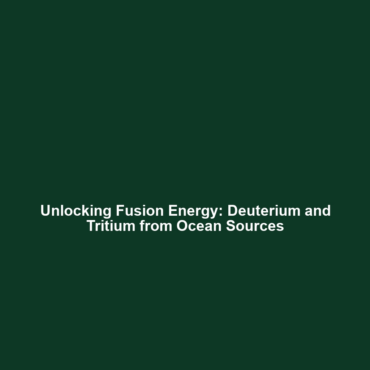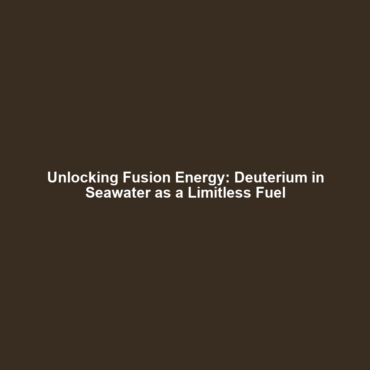Fusion Energy: A Pathway to Carbon-Neutral Power Generation
Introduction
As the world grapples with the urgent need to address climate change, fusion energy emerges as one of the most promising solutions. As a carbon-neutral energy source, fusion could significantly reduce carbon emissions from power generation, thereby playing a pivotal role in mitigating global warming. Unlike fossil fuels, fusion energy harnesses the power of atomic nuclei to produce energy without harmful emissions, making it an attractive alternative for a sustainable future.
Key Concepts
Understanding fusion energy requires a look into several key concepts that highlight its potential:
- Nuclear Fusion: The process where two light atomic nuclei combine to form a heavier nucleus, releasing a substantial amount of energy in the process.
- Deuterium and Tritium: The isotopes of hydrogen used in most fusion reactions, which are abundant and can be extracted from water and lithium.
- Magnetic Confinement: A technique used to contain the hot plasma necessary for fusion, which is critical in preventing the escape of energy.
Fusion energy fits squarely in the category of renewable energies, offering a potential solution to the global need for clean power that can keep up with growing energy demands.
Applications and Real-World Uses
Fusion energy has several potential real-world applications that could revolutionize power generation:
- Electricity Generation: The primary application of fusion energy is the generation of electricity, with the potential to supply vast amounts of clean energy to the grid.
- Desalination: Fusion reactors could provide the heat needed for desalination processes, addressing water scarcity in many regions.
- Hydrogen Production: The excess heat from fusion reactions could enable efficient hydrogen production, promoting the use of hydrogen as a clean fuel source.
Current Challenges
Despite its potential, there are several challenges that researchers face in developing fusion energy:
- Technological Hurdles: Building a stable reactor that can sustain fusion reactions is technologically demanding.
- High Costs: The initial investment for fusion research and infrastructure is substantial, posing financial challenges.
- Regulatory Issues: Fusion energy must navigate complex regulatory frameworks that govern nuclear technologies.
Future Research and Innovations
The future of fusion energy is filled with promise as researchers strive to overcome current obstacles:
- Breakthrough Research: Projects like ITER (International Thermonuclear Experimental Reactor) are paving the way for commercial fusion reactors.
- Improved Materials: Research into advanced materials that can withstand extreme conditions is critical for the success of fusion reactors.
- Next-Gen Technologies: Innovations such as laser-driven fusion and smaller modular reactors offer exciting alternatives to traditional designs.
Conclusion
Fusion energy represents a revolutionary approach to power generation, offering a carbon-neutral source that can significantly reduce carbon emissions and help mitigate global warming. As research and technology advance, the potential applications of fusion energy can transform the energy landscape. To stay informed on the latest developments in fusion energy and its impact, consider exploring more about fusion technology and sustainable energy solutions.


